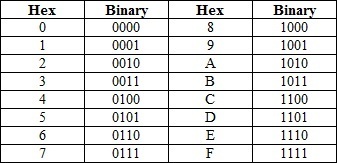IPv6 address format
An IPv6 address is 128 bits long, much larger than a 32-bit IPv4 address. Also, unlike IPv4, which uses a dotted-decimal format with each byte ranges from 0 to 255, IPv6 uses eight groups of four hexadecimal digits separated by colons. Here is an example IPv6 address:
2340:0023:AABA:0A01:0055:5054:9ABC:ABB0
As you can see from the IPv6 address listed above, there are letters in the address. If you are not familiar with the hexadecimal – binary conversion, here is a table that will help you:
IPv6 address shortening
The IPv6 address listed above looks daunting, right? Well, there are two conventions that can help you shorten what must be typed an IPv6 address:
1. a leading zero can be omitted
For example, the address listed above (2340:0023:AABA:0A01:0055:5054:9ABC:ABB0) can be shorten to 2340:23:AABA:A01:55:5054:9ABC:ABB0.
2. successive fields of zeroes can be represented as two colons (::)
For example, the IPv6 address of 2340:0000:0000:0000:0455:0000:AAAB:1121 can be shorten as 2340::0455:0000:AAAB:1121
Here are a couple of more examples of IPv6 address shortening:
Long version – 1454:0045:0000:0000:4140:0141:0055:ABBB
Shortened version – 1454:45::4140:141:55:ABBB
Long version – 0000:0000:0001:AAAA:BBBC:A222:BBBA:0001
Shortened version – ::1:AAAA:BBBC:A222:BBBA:1




